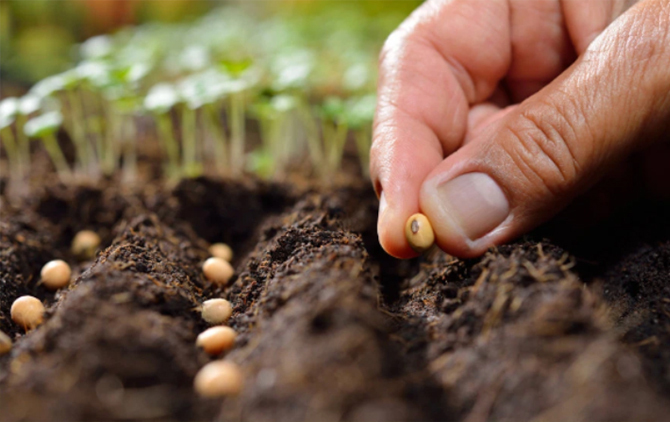Direct Sowing Method: Advantages And Operation

14 May, 2021
Direct Sowing Method: Advantages And Operation
In agriculture, zero tillage or direct seeding is considered the system that tries to avoid ploughing the soil at all costs, so that it has greater protection and does not lose its consistency or properties. Types of direct sowing are considered not only to the action of not ploughing the soil manually or mechanically but also to activities such as crop rotation or covering the soil with residues from the last harvest.
The Direct Seeding System
Direct seeding methods suggest little or no soil disturbance. With conventional planting, the top layer is removed before planting and helps aerate the soil, incorporate manure and fertilizers, prepare the soil for future fragile seedling roots, destroy pests and eradicate weeds. However, this technique strongly favors soil erosion, removes mulch, causes an imbalance in microorganism communities, and releases carbon from the soil into the air, contributing to the greenhouse effect.
So what is direct seeding and what techniques do you use to plant the seeds, if the soil is not to be disturbed? The following practices constitute the fundamental approaches to this idea.
Absence of zero tillage
The direct seeding method of agriculture requires special equipment (disc or agricultural seeders) to make furrows, immediately plant the seeds, fix them and cover them (as opposed to the double pass through the field after plowing). In this way, the soil undergoes minimal disturbance, since exactly where the seed should fall is excavated. In addition, the seeders allow spending the minimum necessary fertilizer, applying it directly in the furrow through tubes.
Sometimes no-till farming involves less tilling between seasons if there is a lot of manure and it decomposes poorly, inducing disease or interfering with planter operations. Another case is the incorporation of lime to balance the acidity.
Thatched Ground Cover
Weed control is one of the main concerns in no-till agriculture, as weeds cannot be mechanically destroyed. To solve the problem, farmers cover the intermediate rows with straw, dry hay, or mulch. This not only helps to suppress weeds due to lack of light, but it also accumulates moisture and protects the roots of the plants from the scorching sun.
Crop Rotation
Crop rotation is an effective technique of agriculture with multiple benefits. As a no-till cultivation method, it helps with:
- weed infestations and pest invasions, as different types of crops, have different threats;
- soil erosion, as different plants have different roots.
- soil fertility, due to the property of legumes to release nitrogen.
Crop Monitoring is a tool for online farming that greatly facilitates decisions about crop rotation and the application of no-till farming. It allows a comprehensive monitoring and analysis of the state of the vegetation in real-time, as well as the last five years. By combining multi-year weather conditions with data on vegetation indices, farmers can choose the most suitable crop for the specific climatic needs of each plant. In short, they can choose the most appropriate crop for each field.
How does direct sowing affect the soil?
The word "till" (to plough) has its origin in the Proto-Germanic language which means "to cultivate". The main objectives of no-till farming are to avoid tillage with the soil in mind.
How does no-till agriculture help with soil erosion?
No-till agriculture waterproofs the soil and reduces erosion. Tillage breaks the surface of the land, displacing the cover layer inward, and thus bare soil is subject to erosion due to its weakened structure. Deprived of the covering material, erosion is accentuated due to water flows, especially in sloping areas, and winds. Rain erosion is another issue to consider, as flexible particles are easily dislodged in heavy rains. Thus, the absence of soil modifications explains why direct seeding protects the soil from erosion since it eliminates these problems.
Why is direct seeding important for carbon retention in the soil?
No-till agriculture is essential for carbon sequestration in the soil. Tillage moves carbon from the soil to the surface of the soil. The released carbon provides nutrients to the plants, which is good. However, it reacts with the oxygen in the atmosphere joining carbon dioxide, which is bad due to the greenhouse effect, so carbon retention in direct seeding agriculture is a great advantage to take into account since here carbon remains in the soil. Therefore, no-till agriculture and carbon dioxide reduction are closely related.
How does direct tillage help preserve soil fertility?
No-till farming helps conserve the soil and preserve its fertility. Carving interferes with the balance between flora and fauna, affecting micro-communities. It helps to mechanically control adult pests and their larvae, but at the same time destroys beneficial species. With direct seeding, certain soil microorganisms in their natural habitats can improve soil fertility through their activities. Another contribution of no-till agriculture to soil fertility is nitrogen enrichment of legumes, useful for subsequent crops within crop rotation.
What are the advantages of direct seeding?
Maintaining the health of the soil is just one of the advantages of direct seeding. The main benefits of direct seeding are, among others:
- Savings in tillage equipment needed to plough the field. Modern machines allow sowing directly into the holes created in the ground. In addition, plants can obtain nutrients from decomposed matter without a problem.
- Reduced fuel consumption in field operations.
- Reduction of working time. Sophisticated planters get the job done faster, completing it in a single pass through the field.
- Elimination of labour in operations and machinery maintenance.
- Conservation of humidity and reduction of water consumption due to the slowing down of evaporation and low cracking.
- Elimination of herbicide loss due to less frequent irrigation.
Analyzing the pros and cons of no-till farming, more and more farmers are switching to this new method year after year, encouraged by the conservation programs of the Ministry of Agriculture & Farmers' Welfare.
